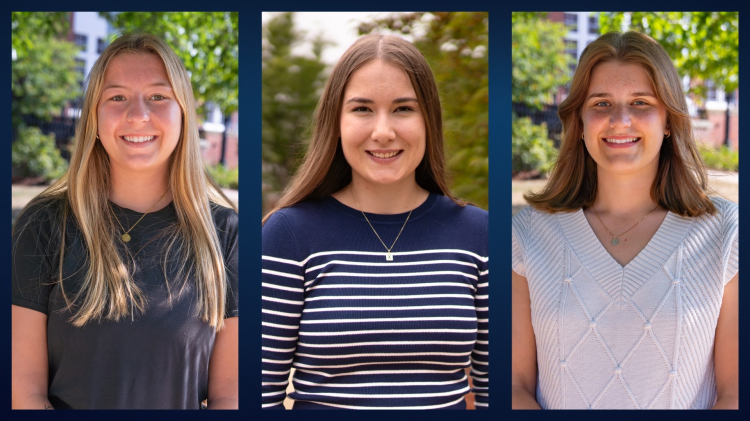From research work investigating how to support circular agriculture to finding a cleaner, more sustainable way to make ammonia, three StFX students had the opportunity to challenge themselves and to make a positive difference in society as the recipients of the John P. Cunningham Internship (Chemistry) and the Richard Cunningham Engineering Internship.

L-r, are Lauren Gatto and Amaya Giraudier, recipients of the John P. Cunningham Internship (Chemistry); and Maddy Hill, who received the Richard Cunnigham Engineering Internship.
Maddy Hill of Beaver Bank, NS, a fourth year student completing a Bachelor of Science in Mathematics with a Diploma in Engineering, is the recipient of the Richard Cunningham Engineering Internship.
Lauren Gatto, a fourth year honours chemistry student from Elmsdale NS, and Amaya Giraudier of Assiniboia, SK, also a fourth year honours chemistry student, each received the John P. Cunningham Internship (Chemistry).
Each award is for $9,000 and provides 16 weeks of work under the supervision of a StFX faculty member.
RICHARD CUNNINGHAM ENGINEERING INTERNSHIP
Ms. Hill says with the global population growing quickly, there is increasing pressure on the agriculture industry to be more sustainable, and to help address food scarcity. She says one promising approach is using insect-based feed for livestock instead of traditional options like soybean meal or fishmeal. Insect feed requires less land and water, helps reduce deforestation, lowers the carbon footprint of farming, and can even reduce the need for antibiotics in poultry production.
"My research explores how to repurpose waste from insect-fed chickens, specifically their manure and eggshells, as a natural fertilizer for crops and for hydroseeding. The goal is to support circular agriculture by turning a large, unavoidable waste stream into a valuable resource," says Ms. Hill, who is supervised by Dr. Brittany MacDonald-MacAulay.
"The success of this project will provide information that could help to reduce the need for synthetic fertilizers, cut greenhouse gas emissions, and keep more waste out of landfills, creating both environmental and economic benefits."
PREPARING ARTICLE
This research is an exciting first step in exploring how different types of livestock feed can affect the usefulness of chicken manure and eggshells as fertilizer, she says. "As we finish analyzing the data, Dr. MacDonald-MacAulay and I are preparing a peer-reviewed article to share our findings. Looking ahead, future research could include directly comparing the waste from chickens fed with traditional feed to that from insect-fed chickens, to better understand the potential advantages for this sustainable agricultural practice."
Ms. Hill says the experience has given her valuable skills, allowing her to be involved in every stage of the project, from planning and writing the proposal to carrying out the experiments, analyzing results, and presenting the findings in a report.
"Having the opportunity to engage in the full research process is a unique experience for an undergraduate student, and I feel very grateful for it. It has been truly invaluable in preparing me to tackle future academic and professional goals."
Ms. Hill says a main reason she chose to pursue engineering was to make a positive impact on the environment and this project gave her the opportunity to do that. Working alongside her faculty supervisor, she says she learned how to use an engineering mindset to approach complex environmental challenges. "More than anything I'm proud that the work I contributed this summer will add to the growing body of knowledge on circular agriculture, supporting sustainable farming practices and global food security.
"This project has helped me grow as both a student and a future professional. I've strengthened important skills such as time management, adaptability, and technical writing, while also learning how to work more independently and manage change as projects evolve. One of the most rewarding parts of the experience was collaborating with Dr. Lord Abbey from Dalhousie's Department of Agriculture and Dr. MacDonald-MacAulay. Through this, I saw firsthand how multidisciplinary teams draw on each member's unique skills to solve problems. I learned that engineers have a role in many different industries, including academia."
JOHN P. CUNNINGHAM INTERNSHIP (CHEMISTRY)
Ms. Giraudier of Assiniboia, SK, who is supervised by Dr. Erwan Bertin, focused her research on finding a cleaner, more sustainable way to make ammonia, an important chemical used in fertilizers, medicine, textiles, and as a potential way to store hydrogen for clean energy. The method she studied is called electrochemical nitrate reduction, which converts nitrate (a common water pollutant) into ammonia using an applied potential.
Over the summer, she prepared copper-cobalt nanoparticle catalysts for this reaction and optimized the operating conditions that affected their performance. The goal moving forward is to build a flow cell device, test the durability of the catalysts, and determine the best operating conditions for efficiency and long-term use.
"I was able to optimize several parameters of my catalyst, including the loading amount, the binder content, the carbon-to-catalyst ratio, and the copper-to-cobalt ratio. With these results, my next steps will be assembling a flow cell and testing the catalyst's durability in longer experiments."
Ms. Giraudier presented her research at ChemCon 2025 in PEI. "I shared my work with other students and professors and got valuable feedback through their questions. It was also a great opportunity to learn from others' projects and connect with people in the chemistry community."
Receiving the Cunningham award inspired her to pursue an honours degree in chemistry.
"Working on research this summer showed me how much I enjoy this kind of work, and it has motivated me to apply for a master's in chemistry. It also made me excited about building a future career in this field. This experience has reinforced my desire to continue in chemistry at an advanced level. It gave me hands-on research skills, a deeper understanding of experimental work, and confidence in pursuing challenging projects."
CHANGE TOWARD GREEN ENERGY
"This opportunity has been such an important step for me as I look ahead to my future studies. I had the chance to work closely with others in the lab and even collaborate with students and researchers from different universities. These experiences not only strengthened my passion for chemistry but also gave me more confidence and excitement about where research can take me," says Ms. Gatto of Elmsdale, NS.
The fourth year honours chemistry student, supervised by Dr. Geniece Hallett-Tapley, worked in a photochemistry lab and focused on generating hydrogen gas using a photocatalyst and UV light. She then used the hydrogen generated to drive chemical reactions used in pharmaceutical synthesis. She successfully synthesized a photocatalyst that produced a promising yield of hydrogen while remaining green and sustainable.
"The results were highly encouraging," she says.
The highlight of her summer was attending the Atlantic Provinces Chemistry Conference (Chem Con), hosted by Science Atlantic. "I had the opportunity to present my findings in a poster session and to attend numerous presentations that deepened my knowledge of chemistry. It was fun to interact with people who all had the same interests as myself."
The summer was extremely rewarding, she says, as she got to work closely with friends and her supervisor Dr. Hallett Tapley. "Sustainable research has always been one of my interests, and getting the opportunity to be part of the change toward green energy was not possible without receiving this grant."













